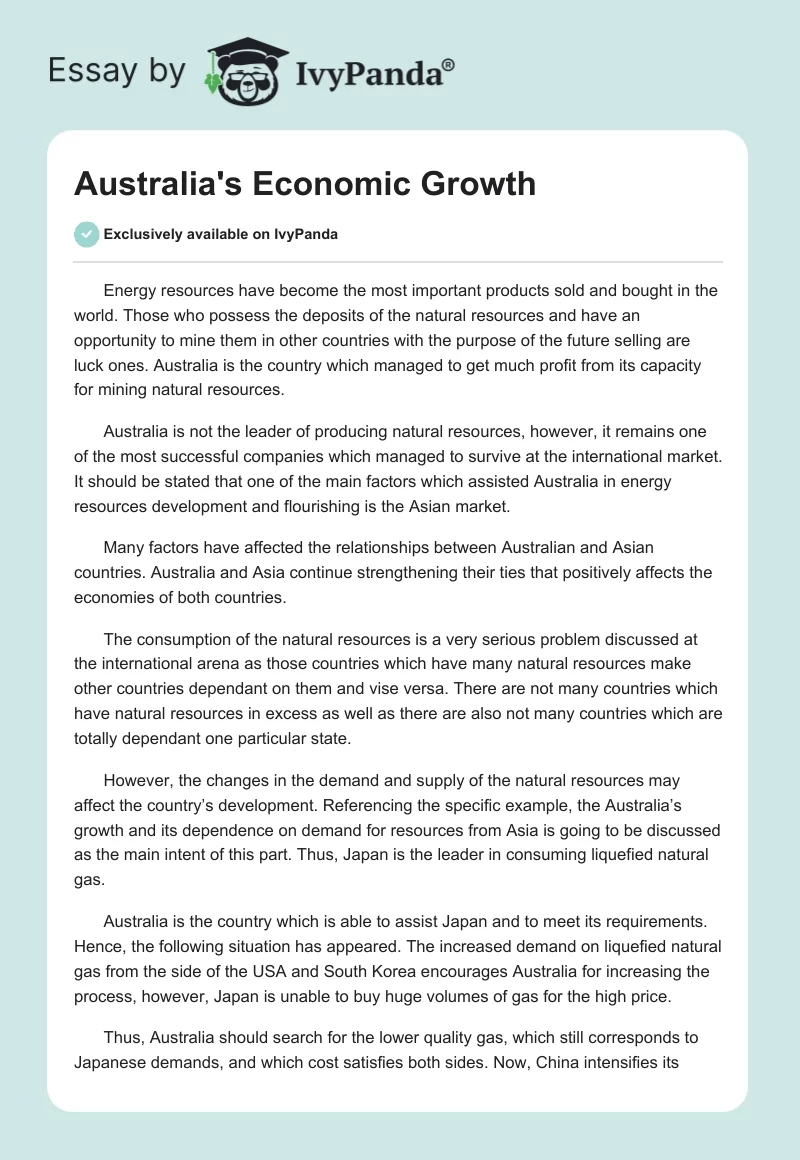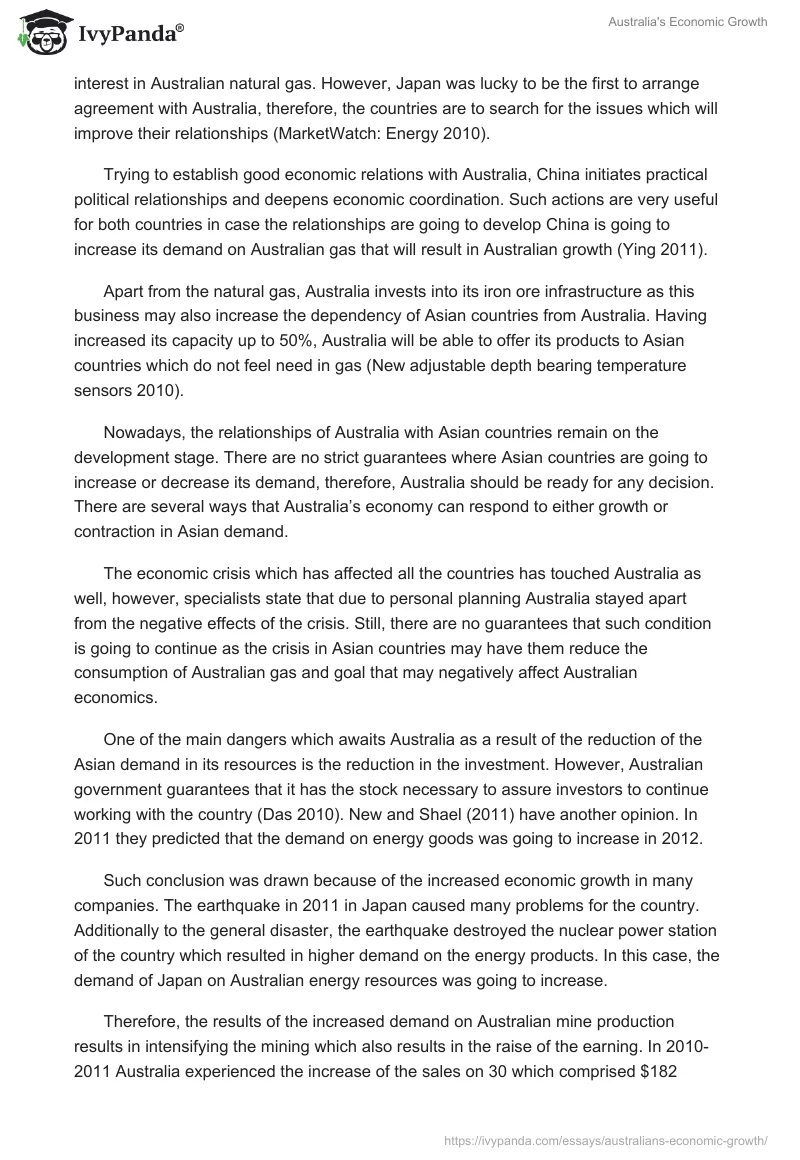Energy resources have become the most important products sold and bought in the world. Those who possess the deposits of the natural resources and have an opportunity to mine them in other countries with the purpose of the future selling are luck ones. Australia is the country which managed to get much profit from its capacity for mining natural resources.
Australia is not the leader of producing natural resources, however, it remains one of the most successful companies which managed to survive at the international market. It should be stated that one of the main factors which assisted Australia in energy resources development and flourishing is the Asian market.
Many factors have affected the relationships between Australian and Asian countries. Australia and Asia continue strengthening their ties that positively affects the economies of both countries.
The consumption of the natural resources is a very serious problem discussed at the international arena as those countries which have many natural resources make other countries dependant on them and vise versa. There are not many countries which have natural resources in excess as well as there are also not many countries which are totally dependant one particular state.
However, the changes in the demand and supply of the natural resources may affect the country’s development. Referencing the specific example, the Australia’s growth and its dependence on demand for resources from Asia is going to be discussed as the main intent of this part. Thus, Japan is the leader in consuming liquefied natural gas.
Australia is the country which is able to assist Japan and to meet its requirements. Hence, the following situation has appeared. The increased demand on liquefied natural gas from the side of the USA and South Korea encourages Australia for increasing the process, however, Japan is unable to buy huge volumes of gas for the high price.
Thus, Australia should search for the lower quality gas, which still corresponds to Japanese demands, and which cost satisfies both sides. Now, China intensifies its interest in Australian natural gas. However, Japan was lucky to be the first to arrange agreement with Australia, therefore, the countries are to search for the issues which will improve their relationships (MarketWatch: Energy 2010).
Trying to establish good economic relations with Australia, China initiates practical political relationships and deepens economic coordination. Such actions are very useful for both countries in case the relationships are going to develop China is going to increase its demand on Australian gas that will result in Australian growth (Ying 2011).
Apart from the natural gas, Australia invests into its iron ore infrastructure as this business may also increase the dependency of Asian countries from Australia. Having increased its capacity up to 50%, Australia will be able to offer its products to Asian countries which do not feel need in gas (New adjustable depth bearing temperature sensors 2010).
Nowadays, the relationships of Australia with Asian countries remain on the development stage. There are no strict guarantees where Asian countries are going to increase or decrease its demand, therefore, Australia should be ready for any decision. There are several ways that Australia’s economy can respond to either growth or contraction in Asian demand.
The economic crisis which has affected all the countries has touched Australia as well, however, specialists state that due to personal planning Australia stayed apart from the negative effects of the crisis. Still, there are no guarantees that such condition is going to continue as the crisis in Asian countries may have them reduce the consumption of Australian gas and goal that may negatively affect Australian economics.
One of the main dangers which awaits Australia as a result of the reduction of the Asian demand in its resources is the reduction in the investment. However, Australian government guarantees that it has the stock necessary to assure investors to continue working with the country (Das 2010). New and Shael (2011) have another opinion. In 2011 they predicted that the demand on energy goods was going to increase in 2012.
Such conclusion was drawn because of the increased economic growth in many companies. The earthquake in 2011 in Japan caused many problems for the country. Additionally to the general disaster, the earthquake destroyed the nuclear power station of the country which resulted in higher demand on the energy products. In this case, the demand of Japan on Australian energy resources was going to increase.
Therefore, the results of the increased demand on Australian mine production results in intensifying the mining which also results in the raise of the earning. In 2010-2011 Australia experienced the increase of the sales on 30 which comprised $182 billion (New & Shael, 2011). It is obvious that Australia managed to suffer the less damage after the crisis and there are several factors which helped it remain in advantage.
The successful concatenation of circumstances for Australia helped it remain with profit during the time when other energy mining industries in other countries were in crisis. Moreover, Australia was ready for the crisis, it has made some preparations, therefore, the affect was little on its economics (Edwards 2010).
There are a lot of countries which add to the development of the Australian resource industry. Aurora Oil & Gas Limited and Northern Iron Limited are the companies which deal with mining and distributing the resources of the country to consumers. These two countries present their products both at the national and international arenas.
Northern Iron Limited is an Australian company which extracts the deposits of energy resources in Norway. Having bought an individual right to work with Sydvaranger on the territory of Norway, the company assists Australian economy by means of exporting high quality iron ore concentrate to steel industry customers all over the world.
Producing the energy resources on the territory of other countries, Northern Iron Limited supports Australia greatly as the income comes to the country bit the resources are not touched (Northern Iron Limited 2011). Such strategy is very useful and profitable and many Australian companies work in such a way. Aurora Oil & Gas Limited operates on the territory of the North America, exploring and producing oil and gas there.
The company performs the same functions. Operating in another country, using the resources of other states, the company brings profit to Australia that influences the country raise. The economical stability of Australia is difficult to ruin as apart from the companies which operate on the territory of the country there are a lot of other companies which perform their tasks on the territories of other countries.
The company pursues the following strategic goals, to apply the company’s assets in an advanced manner and to provide sustainable returns, to adopting high standards of occupational health and safety, and to foster a culture of care and professional excellence from employees (Aurora Oil & Gas Limited 2013).
Aurora Oil & Gas Limited is planning to intensify its expansion to Asia having increased the stock to the region. Producing the resources in another part of the world, it is better for the company to organize the stock of the products at once rather than to search for the storage of the commodities and then deliver them to the final spot of destination.
It should be stated that nowadays, the company stock has reduced, however, the search for new stock markets may solve this problem. The geographical position of the place where the resources are extracted is favorable for intensifying the relationships between Aurora Oil & Gas Limited and Asian region, especially during the time when there is a high demand.
Therefore, it may be concluded that Australia remains at the top due to its economic ties with Asian consumers. Many factors have affected the relationships in the region and now it is high time to intensify and develop these relationships. Australian government works in the correct direction trying to develop political connection between the countries.
However, being the leaders in consuming liquid natural gas, Asian countries should feel that Australia is the only country which is going to assist the Asian region. Australia is interested in selling its products in Asia as these countries may become long term consumers. The possibility to develop political and economical ties with Asian countries is a good chance for Australia to develop durative relationships with Asia based on the energy resources.
Reference List
Aurora Oil & Gas Limited 2013. Web.
Das, S 2010, ‘A vulnerable state — the economic outlook for Australia’, Keeping good companies, February, pp. 15-19.
Edwards, J 2010, ‘Australia after the global financial crisis’, Australian Journal of International Affairs, vol. 64, no. 3, pp. 359-371.
‘MarketWatch: Energy’ 2010, Datamonitor, May, pp. 161-162.
‘New adjustable depth bearing temperature sensors’ 2010, Coal International, November/December, p. 24.
New, R & Shael, T 2011, ‘Energy and minerals overview’, Australian commodities, vol. 18, no. 2, pp. 85-90.
Northern Iron Limited 2011. Web.
Ying, D 2011, ‘Australian PM’s visit boosts cooperation’, Beijing Review, 5 May, pp. 10-11.


